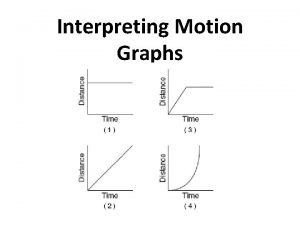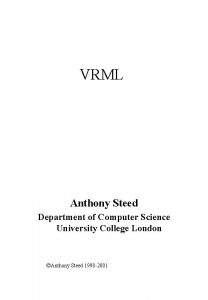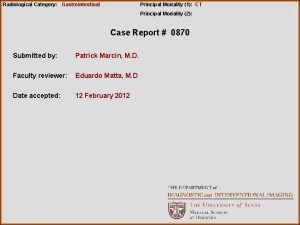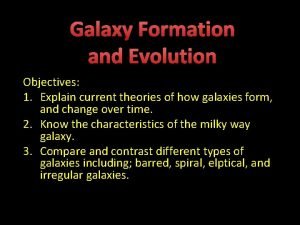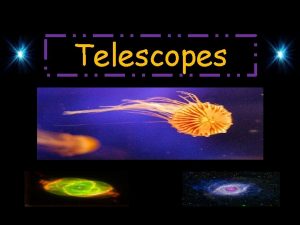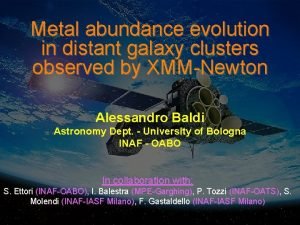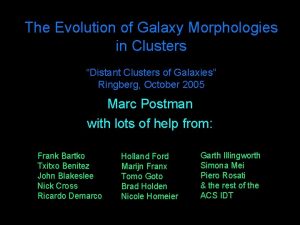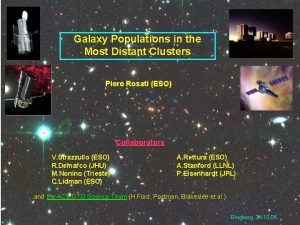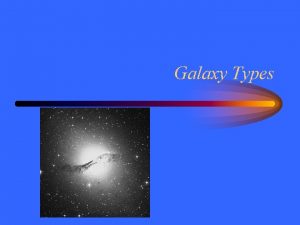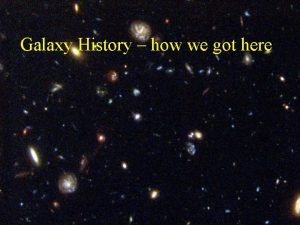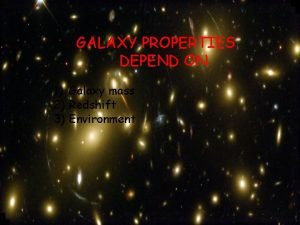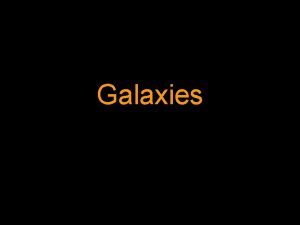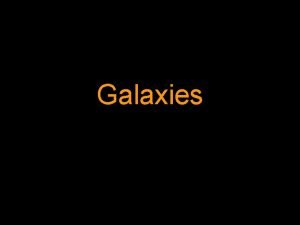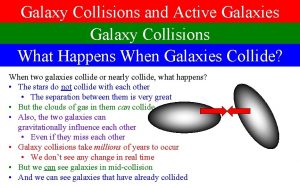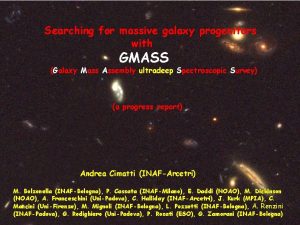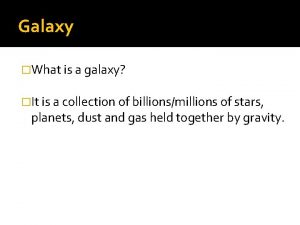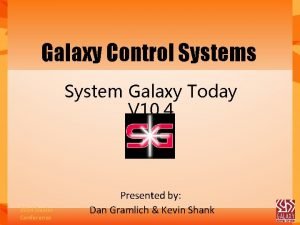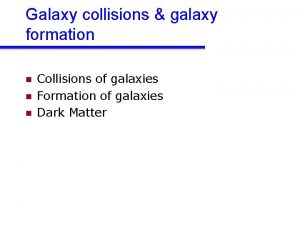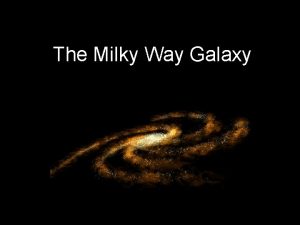M 51 Whirlpool Galaxy 31 million LY distant


























- Slides: 26

M 51 Whirlpool Galaxy 31 million LY distant 30, 000 LY across February 28, 2006 Chapter 24: The Milky Way Galaxy Astronomy 2010 1

How Do We Determine the Shape of the Galaxy? We are in the galaxy and can’t easily step back to see what it looks like. u William Herschel: measure the distance and direction to stars and make a map. u • Dust obscures view of much of the galaxy. u Harlow Shapley: measure the distance and direction to globular clusters scattered above and below the galaxy • away from the dust u Modern: use radio and infrared light February 28, 2006 Astronomy 2010 2

February 28, 2006 Mosaic of 51 wide-angle photographs. Made over a three year period from locations in California (USA), South Africa, and Germany, the individual pictures were digitized and stitched together to create an apparently seamless 360 by 180 degree view. Astronomy 2010 3

February 28, 2006 Astronomy 2010 4

u u NGC 4103, 55 million LY away edge on spiral galaxy dark dust band 500 LY thick u February 28, 2006 Astronomy 2010 5

side February 28, 2006 Astronomy 2010 top 6

center of galaxy obscured by dust February 28, 2006 Astronomy 2010 7

Our Milky Way Galaxy February 28, 2006 Astronomy 2010 8

The Milky Way Galaxy u u stars grouped in galaxies our galaxy: the Milky Way • roughly disk shaped, 100, 000 LY diameter • 1000 LY thick u u central spherical nuclear bulge, 4 major spiral arms plus smaller “spurs” • arms: Cygnus, Perseus, Sagittarius-Carina • fourth unnamed arm – hard to see (on other side of bulge) • 80, 000 LY long u Sun in short spur – the Orion arm – between Perseus and Carina • • • 15, 000 LY long also contains Orion Nebula Sun in middle of disk, 70 LY from central plane February 28, 2006 Astronomy 2010 9

Spiral Arms u u u February 28, 2006 Astronomy 2010 hot blue stars delineate spiral structure – like Xmas lights on a tree arms: regions where gas and dust more densely concentrated need dust to replenish short lived blue stars cool orange and red stars found in and between spiral arms interstellar dust limits our view in visible light to dashed circle 10

Why Spiral Arms? u u stars orbit around center of mass of galaxy – like planets Kepler’s Laws: • closer in – faster • farther out – slower differential rotation of stars explains curved shape of spiral arms February 28, 2006 u Astronomy 2010 11

u Rotation Speeds • Inner Parts: Rise from Zero to few 100 km/sec • Outer Parts: Nearly constant at a few 100 km/sec u Sun has Vrot=220 km/sec at R=8. 5 kpc Orbital Period: 240 Myr u February 28, 2006 Astronomy 2010 12

Rotation Spiral Arms February 28, 2006 Astronomy 2010 13

Spiral pattern for billions of years? Spiral density waves February 28, 2006 Astronomy 2010 14

February 28, 2006 Astronomy 2010 15

Spiral Density Waves: Traffic Jam February 28, 2006 Astronomy 2010 16

Spherical Structure Nuclear Bulge • Many RR Lyrae stars • A little gas & dust Galactic Halo: outer sphere with very few stars • • Old metal-poor stars Globular clusters dark matter RR Lyrae Stars RR Lyrae stars • pulsate like Cepheid Variables • distance scale February 28, 2006 Astronomy 2010 17

Galactic Center February 28, 2006 Astronomy 2010 18

Galaxy Mapping with Radio Band u u u radio is best for mapping the distribution of hydrogen in the galaxy most of the hydrogen gas is not ionized because O and B stars are radio waves pass easily through dust February 28, 2006 Astronomy 2010 19

Stellar Populations Population I: Disk Stars u Ordered, roughly circular orbits in a plane. u All orbit in the same general direction. u Orbit speeds similar at a given radius. February 28, 2006 Population II: Spheroid Stars u Disordered, elliptical orbits at all inclinations. u Mix of regular and retrograde orbits u Wide ranges of orbital speeds. Astronomy 2010 20

Population I Location: Disk and Open Clusters u Age: Mix of young and old stars u Composition: Metal rich (roughly solar) u 70% Hydrogen u 28% Helium u ~2% "metals" u Environment: Often gas rich, especially for the young stars. u February 28, 2006 Astronomy 2010 21

Population II Location: Spheroid and Globular Clusters u Ages: Oldest stars, >10 Gyr u Composition: Metal Poor (0. 1 -1% solar) u 75% Hydrogen u 24. 99% Helium u ~0. 01% metals u Environment: gas poor, no star formation u February 28, 2006 Astronomy 2010 22

Contrast & Compare Population II u Disk & Open Clusters u Spheroid & Globular Clusters u Young & Old Stars u Oldest Stars u Metal-rich u Metal-poor u Blue M-S stars u No Blue M-S stars u Ordered, circular orbits in a plane u Disordered, elliptical orbits in all directions. u Gas-rich environment with recent star u Little or no Gas & formation. Dust, and no star formation. February 28, 2006 Astronomy 2010 23

Mass of the Milky Way Observe orbital period, P, of stars or interstellar matter vs. distance, D, from center Kepler’s Third Law period of orbit determined by mass within orbit: D 3 = (Mgalaxy + Msun) P 2 earth orbit sun’s mass ufarther from the galactic center, the more mass within orbit FIND: more mass than we see -- dark matter halo u February 28, 2006 Astronomy 2010 24

Dark Matter u Two possibilities to explain the observed rotation: • Law of gravity is wrong for galaxies. • There is additional matter that doesn’t emit detectable radiation (dark matter). No evidence that gravity behaves differently. u The “dark matter” hypothesis is favored. u • Could be brown dwarfs, black holes, or new exotic particles. u Measurements indicate about 90% of the mass in the universe is dark matter! February 28, 2006 Astronomy 2010 25

Galaxy Formation February 28, 2006 Astronomy 2010 26
 Spiral elliptical and irregular
Spiral elliptical and irregular Retrograde motion of mars
Retrograde motion of mars Distant goal meaning
Distant goal meaning Trade winds soft through the sighing trees
Trade winds soft through the sighing trees Lod example
Lod example Peace is not merely a distant goal
Peace is not merely a distant goal Non western artists
Non western artists Interpreting motion graphs
Interpreting motion graphs Distant past tense
Distant past tense Distant
Distant Distant
Distant A dangerous whirlpool personified as a female sea monster
A dangerous whirlpool personified as a female sea monster Contraindications of whirlpool bath
Contraindications of whirlpool bath Whirlpool pure first
Whirlpool pure first Healthscopebenefits.com
Healthscopebenefits.com Whirlpool health insurance
Whirlpool health insurance Whirlpool supply chain
Whirlpool supply chain The whirlpool archetype examples
The whirlpool archetype examples Whirlpool cipher
Whirlpool cipher Haven vs wilderness
Haven vs wilderness Whirlpool sign volvulus
Whirlpool sign volvulus Whirlpool cipher
Whirlpool cipher Whirlpool supplier portal
Whirlpool supplier portal System galaxy tech support
System galaxy tech support Galaxy definition
Galaxy definition Irregular galaxy
Irregular galaxy Hubble galaxy classification
Hubble galaxy classification







